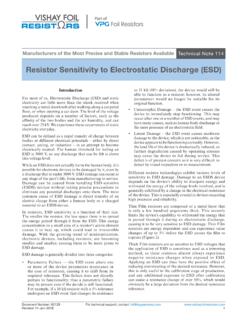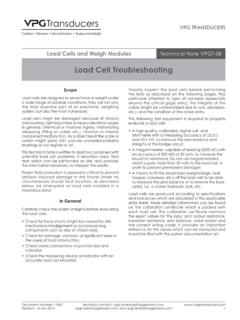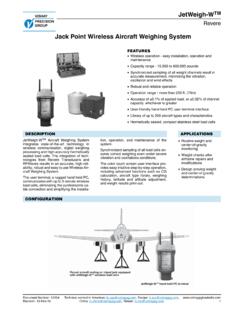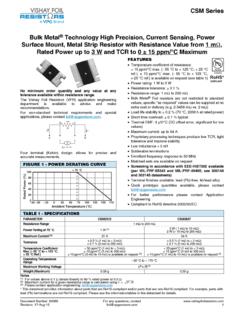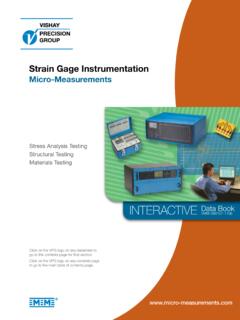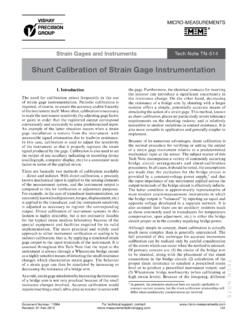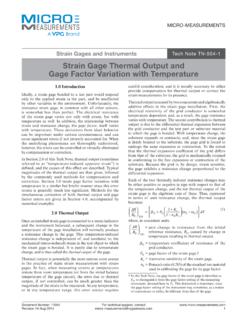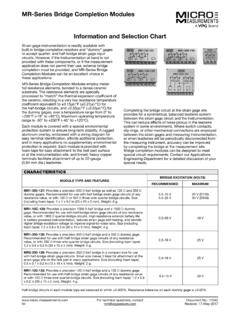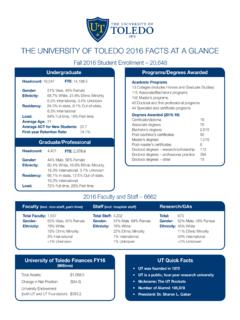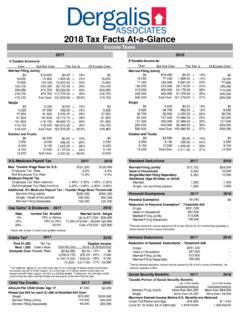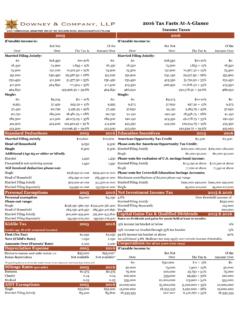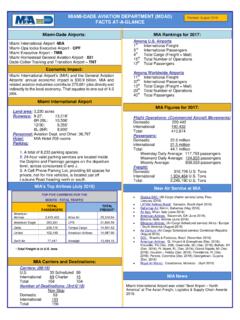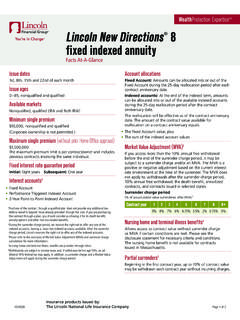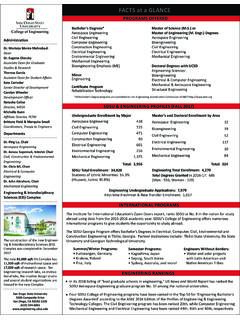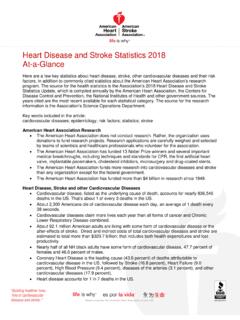Transcription of Facts at a Glance - vishaypg.com
1 Facts at a Glance From: Vishay Foil Resistors July, 2013. Facts #121. Author: Yuval Hernik Tel: +972-54-3000191. E-mail: Reading Between the Lines in Resistor Datasheets Don't believe everything you read. That rule applies not only to your daily news sources but also to component datasheets. In a perfect world, all datasheets would be based on terms that have the same meaning for every supplier. But they're not. Many datasheets should come with a warning label to the effect that terms like tolerance and TCR are being used loosely. As an engineer, you need a healthy skepticism that allows you to decipher incomplete and misleading specifications. The need is particularly urgent given the increasing number of counterfeit sources of precision resistors that unscrupulous suppliers may try to disguise on datasheets with superfluous text, figures, marketing fluff, and half-truths with respect to specifications.
2 The problem is not necessarily that data is being withheld, but that it's being mixed up in a confusing way. As elsewhere in life, the devil is in the details. Realizing that design engineers are under great pressure to quickly assimilate the information in datasheets, we have prepared this article with the goal of offering a strategy that can help any person to reach the fundamentals in a precision resistor datasheet within a few minutes. To this end, we look at the key terms that turn up in these documents and review what they really mean. Tolerance Tolerance has many meanings, ranging from purchase tolerance (initial tolerance) to end-of-life tolerance (total error budget). The last thing you need know in the component selection process is the part's initial tolerance.
3 The first thing you need to know is the required end-of-life tolerance of the design. You need to evaluate all the components for their expected changes after all of the stresses and exposures they might experience over the planned life of the equipment. Every component must have an error budget assigned to it which, if exceeded, will cause the equipment to fall out of its performance specification, or possibly fail. In addition to initial tolerance, the error budget includes allowable shifts through shelf life, assembly, TCR, shock, vibration, humidity exposure, thermal shock, thermal EMF, load-life drift, ESD, radiation, and harmonic distortion (harmonic distortion is a measure of a component's conformance to Ohm's law as a predictor of reliability.) You then need to select a particular resistor technology with the least amount of change through all the stresses, add up all the expected Rs, and subtract these from the end-of-life tolerance limit to arrive at the purchase tolerance.
4 The Bill of Materials Vishay Precision Group 3 Great Valley Parkway, Suite 150 Malvern, PA USA Phone +1-484-321-5300 Fax +1-484-321-5301. Where the World Goes for Precision Measurement and Control Micro-Measurements Vishay Foil Resistors VPG On-Board Weighing VPG Process Weighing VPG Transducers Facts a Glance From: Vishay Foil Resistors July, 2013. Facts #121. (BOM) then specifies the resistor model by resistance, tolerance, and possibly by TCR (usually typical or restricted to a narrow temperature range). Although not delineated on the BOM, each delta-R limit for the specified resistor technology is critical to the application. This is why precision resistors with the same resistance, tolerance, and TCR but of different technologies are not interchangeable: because their changes through service life are not the same.
5 Substitution on the basis of these alone could jeopardize performance and mission success. Only the OEM engineer who did the error budget analysis can determine a suitable substitute. Unfortunately, today we see more and more attempts by certain electronic manufacturing services to replace precision resistors with cheaper solutions that put system performance at risk. To be considered as substitutes, all performance characteristics through all stresses and exposures must be completely and exactly defined in specific detail to be sure they qualify without reducing reliability or shortening equipment life. Particularly for high-precision circuits using high reliability and tight tolerance resistors, it is not enough for the manufacturer to measure the resistors before shipment.
6 Its equipment must be calibrated and traceable to the National Institute of Standards and Technology (NIST, formerly the National Bureau of Standards). Its measurements must also have a guard band that confines measurement error to the specified tolerance and applies this to 100% of the resistors. Also, the OEM must be assured that the resistors are within tolerance when received not just finessed into a measured tolerance long enough to be listed as good for shipment (but not long after). Unfortunately many OEMs' incoming inspection checks are not sufficiently calibrated to measure tight tolerance resistors, so they must depend upon the suppliers' honesty. In addition, some companies have purchased components shipped directly to the production floor, bypassing incoming inspection completely.
7 If the application is important, the supplier must be accessible for qualification inspection and periodic audits. The end customer must also evaluate whether a tolerance offered by a manufacturer is really practical. For example, some surface mount thin film chip resistors are offered in very tight tolerances for very low resistance values. That's impressive on the datasheet but not compatible with assembly processes. As these resistors are mounted on the board there is a resistance change due to solder heat. The solder terminations melt, flow, and re-solidify with changed resistance values. For low-value resistors the amount of resistance change is much greater than the specified tolerance. Having paid a premium price for an impractically tight tolerance, the customer ends up with looser-tolerance resistors once they're assembled on the PCB.
8 Temperature Coefficient of Resistance (TCR). TCR is an area of particular concern because it is often misrepresented or incompletely defined. It is also a characteristic that influences circuit performance from the very first day of operation. Additionally, TCR is often used as an indication of a resistor's overall level of performance. It is assumed, and is generally true, that the lower the TCR, the more precise the resistor. So, if the TCR is not completely and accurately defined, that assumption is invalid and the use of that resistor invalidates all the accuracy, stability and reliability assessments made by the designer. -2- Facts a Glance From: Vishay Foil Resistors July, 2013. Facts #121. The TCR stated on datasheets comes from resistance measurements made after the resistors have stabilized at a specified temperature which defines the limits of a given temperature range, typically for 30 minutes at each temperature.
9 In actual operation, resistors of different physical bodies have different thermal response times and, unlike the measurement conditions, the resistors in the circuit may all be operating at different temperatures from each other and from the ambient temperature. Different operating power levels, different proximities to other components, and other environmental factors will cause resistors to operate at different temperatures. Industry protocols dictate standard measurement procedures. Typically, resistance measurements are made at a reference temperature, a lower temperature, and a higher temperature, and the TCR is defined as the delta-R/Rref in the cold range and the delta-R/Rref in the hot range. For military range applications, these would be 25 C, 55 C, and +125 C, respectively.
10 The TCR defined as R/R vs T, based on only two measurements (+25 C to 55 C, or +25 C to +125 C), assumes a linear TCR even though the R/R = f(T) is a parabola. The characteristic TCR curve only appears to be linear since its basis is two measurements each in the hot range and the cold range, and two points always define a straight line even if they're actually points are on a curve. In fact the instantaneous TCR between these two temperature measurement end points could be much higher. So never assume that TCR is going to be the same over different temperature ranges, unless you're using Bulk Metal Foil technology, which has such a low TCR that it is essentially linear over the full military temperature range. Through various manipulations of temperature during production or materials doping during element development, that characteristic TCR curve may be rotated either clockwise or counter- clockwise (pivoted around the 25 C reference point).
